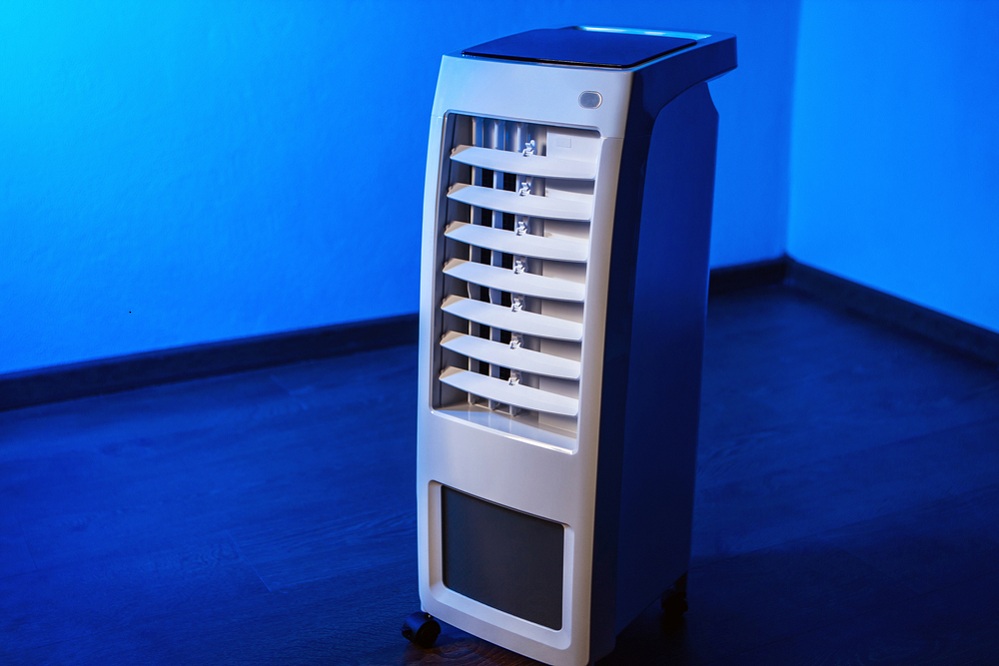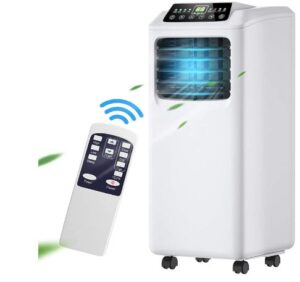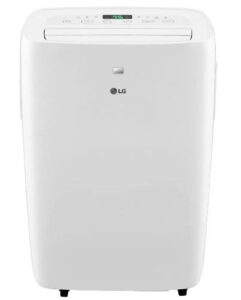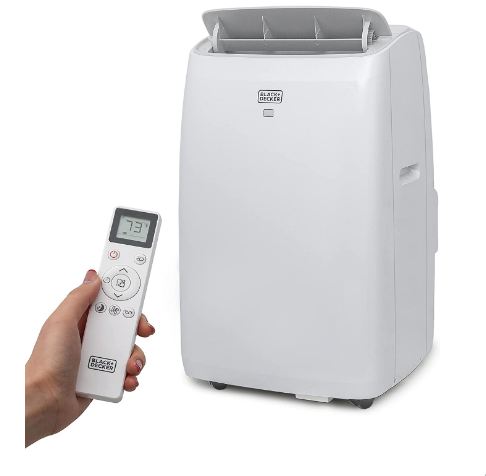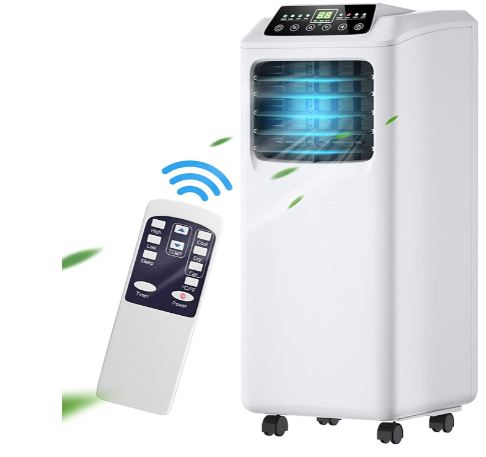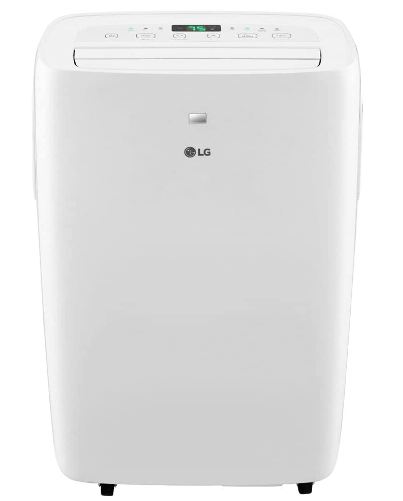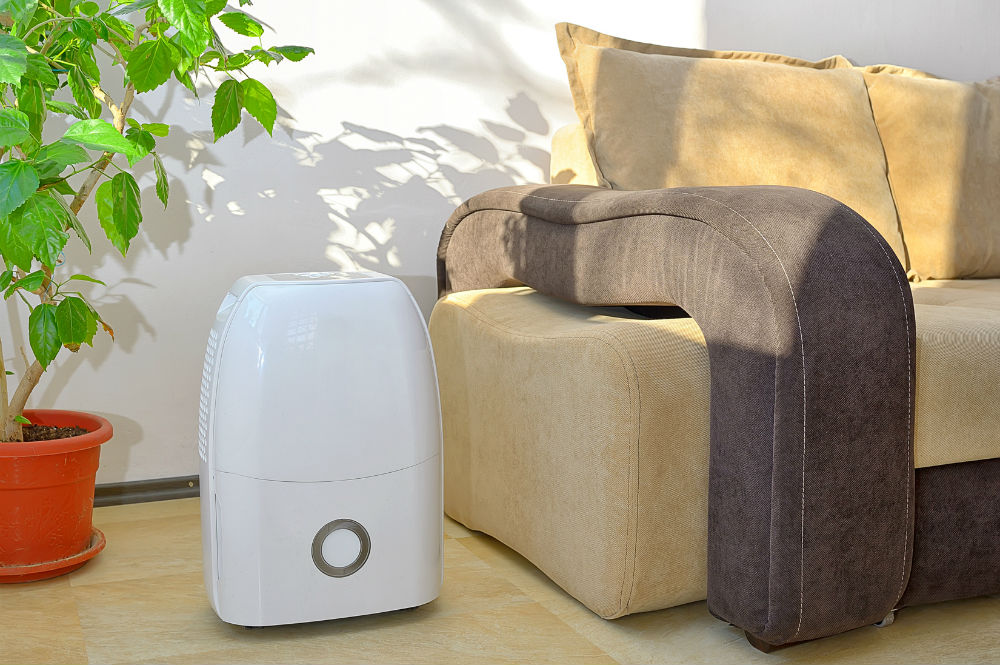Shopping for a Portable Air Conditioner for Your Apartment?You have come to the right place, and that, too, right in time.
The insufferable heat and humidity of the summer call for the best, most efficient cooling system possible.
And as an apartment owner, you’re well aware of the poor ventilation and cooling in apartments.
A fan or two is enough to fix the situation for the most part of the year. But the problem gets quite out of hand once summers come knocking on your door.
And, if you spend most of your day on the terrace or in the garage where central air conditioning is not connected, then the heat can be quite suffocating and simply too hard to handle.
This is where a portable air conditioner comes in handy. It allows you to take your cooling matters into your own hands, and at quite a reasonable price as well.
When should you buy a Portable AC for Your Apartment (vs. a window unit)?
The main advantage portable ACs have over window units is their compact shape. Window units are significantly larger and have outer units almost equally as big as the AC itself.
This means you need to dedicate space for a window AC both inside the house as well as on an external wall or roof of the house.
Now, most apartments don’t have this luxury. There is no ‘roof’ space per se, and the bare walls on the outside often overlook a terrace or balcony, so they are not suitable for AC outer units, either.
In comparison, a portable AC does not require too much space for installation. You only need to connect it to a power source, place it in the corner of a room you need to cool, and you’re done. There’s no need for any wall fixtures or elaborate exhaust systems.
This brings us to another advantage portable ACs offer over window ACs: no-drill installation. This is great for people on a restricted budget. With a portable AC, you don’t have to pay for installation.
No-drill installation is also great if you move a lot.
Imagine getting an AC installed into every apartment you move into, having it taken out when it’s time to move, getting the wall repaired, and eventually paying again to get the AC installed in your new space. With a portable air conditioner, all that hassle goes out the window.
The third key benefit of a portable AC is, well, portability. If you want to have an AC in multiple rooms in your apartment, installing separate ACs in each room would be a financial nuisance. The easier route is to just wheel your portable AC around the house with you!
The portability of such units is also great if you want to make your terraces and garages inhabitable during the summers. These parts of the house typically don’t have much ventilation, let alone any cooling.
Making such an arrangement will be very expensive, as you will have to extend the electrical wiring into the said spaces, get permits for doing so, and buy a new cooling unit – all that only for 3-4 months out of 12.
The best choice in such a situation is a portable AC.
Our Top 3 Picks
- Excellent value for money.
- Multiple modes, including energy saver and sleep mode.
- 4-way airflow ensures even distribution
- Designed for rooms up to 230 square feet.
- The cooling power of 8000 BTUs ASHRAE.
- Comes with a condensate bucket.
- 8000 BTU ASHRAE cooling power.
- Wi-Fi compatibility allows you to pair the AC with smartphones and other smart devices.
- Comes with remote control.
What's In This Buying Guide
Table of Contents
Below, we have reviewed a few of the best portable air conditioners in the market.
We also discuss the features you need to consider when buying a portable AC for yourself. We’ve also listed the pros and cons of a portable AC, so you know exactly what you are getting yourself into.
Towards the end, we also answer frequently asked questions about portable air conditioners.
Finally, we wrap the guide up with our verdict of the best portable air conditioner for an apartment. By the end, you’ll know how to pick the most suitable AC for your apartment.
Best Portable Air Conditioners for Apartments
- 1. Best Overall: Black+Decker BPT10WTB
- 2. Best Budget Buy: Costway Portable Air Conditioner
- 3. Best Budget Buy: LG Smart WiFi Portable Air Conditioner
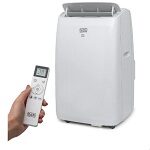
Black+Decker BPT10WTB
BTU
10,000Control Method:
Touch and RemoteFloor Area
450 sq. ft.Dimensions
17.7 x 15.6 x 29.3 inchesBest Overall
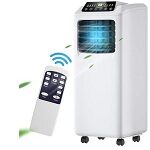
Costway Portable Air Conditioner
BTU
8,000Control Method:
Touch and RemoteFloor Area
230 sq. ft.Dimensions
12 x 13 x 30 inchesBest Budget Buy
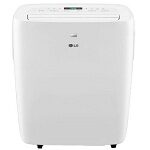
LG Smart WiFi Portable Air Conditioner
BTU
8,000Control Method:
Touch, Connected WiFi devices, and RemoteFloor Area
250 sq. ft.Dimensions
13.27 x 17.32 x 27.36 inchesThe quietest Pick
With its 3-in-1 functionality, the powerful Black+Decker BPT10WTB can operate as a portable air conditioner, dehumidifier, and fan.
PROS
- Bucket-less design helps save storage space.
- Caster wheels enhance portability and facilitate handling.
- Comes with a user-friendly control panel.
- The remote control increases accessibility.
- Self-evaporating design eliminates the hassle of emptying the water bucket.
CONS
- Does not work as well in rooms larger than 300 square feet.
Features
- The cooling power of 10000 BTU ASHRAE.
- No condensate bucket.
- The AC is suitable for small-medium rooms.
- A 24-hour self-timer is built into the machine.
- 3-in-1 functioning - works as an AC, fan, and dehumidifier.
Our Review
What makes the Black+Decker BPT10WTB one of our top picks is its versatility. It is a 3-in-1 device that works as a fan, an AC, and a dehumidifier.
Its formidable cooling power of 10,000 BTU ASHRAE is more than adequate for rooms as big as 300 square feet. The manufacturer says it is designed to cool as much as 450 square feet; however, the larger a space, the longer and harder the machine will have to work.
The Black+Decker BPT10WTB has a bucket-less design. It self-evaporates the water it collects without letting it collect into a condensate bucket. This means you no longer have to worry about drainage.
The self-evaporative makes maintenance a breeze, too. You will only need to filter-cleanse this device once a month.
It is lightweight enough for you to easily carry it from room to room. Add to this some caster wheels, and you get one of the most portable devices.
Moreover, the LED display on the top makes temperature settings easy to manage and read. It also comes with remote control for convenient handling.
The 24-hour timer further adds to the convenience. The timer makes this portable AC largely autonomous, as it will turn itself on and off on its own exactly the way you program it to. This also allows for automatic, all-day running.
The Costway Portable AC might be low in price, but it is full of compelling features that put it toe-to-toe with other models that flaunt much higher price tags. With a powerful 8000 BTU rating, it is ideal for small to medium rooms.
PROS
- Packed with impressive features at an affordable price.
- Remote control adds to the convenience
- Adjustable fan speed
- A sleep mode makes the AC quieter.
CONS
- You need to manually empty the water bucket.
Features
- Designed for rooms up to 230 square feet.
- The cooling power of 8000 BTUs ASHRAE.
- Comes with a condensate bucket.
- 4 operating modes.
- Also works as a dehumidifier.
Our Review
This budget pick has all the features you need from a good portable AC for a smaller apartment. The AC has a fan mode, a cool air conditioning mode, and a dry mode. This lets it work as a fan, AC, and dehumidifier all in one. The fan speeds are adjustable.
In addition to these 3 modes, a supplementary sleep mode brings down the AC’s noise level to 56 dB. This quieter setting, paired with the built-in timer feature, promises restful sleep on a hot night.
The 24-hour timer makes the AC automatically turn off after 24 hours of continuous operation. This not only safeguards the machinery and wiring housed inside the unit but also helps conserve energy.
The Costway model also has an auto-restart feature. In case of a power outage, the AC reconfigures to its setting pre-shutdown without you needing to reset it all over again.
Thanks to the free-spinning caster wheels fitted on the body, the AC is easy to move around the apartment. The top of the unit features a simple set of controls, and remote control makes the machine even handier.
The control panel also has an indicator for a full water bucket. It tells you when you need to power the AC off and empty the condensate bucket.
Only as loud as light rainfall, you won’t even notice the LG portable AC while it runs at full speed. Talk about sleeping in peace!
PROS
- Almost whisper-quiet when it is in its best shape.
- Very easy to set up.
- You can control it even when you are away from home.
- Comes with a user-friendly LED display and remote control.
- Adjustable fan speed
CONS
- It struggles to cool rooms bigger than 250 square feet.
Features
- 8000 BTU ASHRAE cooling power.
- Wi-Fi compatibility allows you to pair the AC with smartphones and other smart devices.
- Comes with remote control.
- The noise level is only 50 dB.
- 3 operating modes: AC, dehumidifier, and fan.
Our Review
Given how portable air conditioners are designed primarily for smaller spaces, it is unfortunate how loud they are sometimes. But this 8000 BTU model by LG puts an end to all such woes because it only makes 50 dB of noise.
Even though its quietness is akin to that of a drizzle, it is still powerful enough to cool rooms up to 250 square feet. This makes it just the right pick for a small bedroom or studio apartment where even the quietest sounds can disturb you.
The LG AC also doubles as a dehumidifier. You can also turn off the cooling and just use it as a fan! There are two cooling modes, two fan speeds, and an auto-swinging vent to ensure an even spread of air around the room.
The star feature of this portable AC is WiFi compatibility. If your apartment has a range of smart devices, it will greatly help if you can also pair your AC with them.
Similarly, if you are a tech-enthusiast, you may expect all your household appliances to be WiFi-enabled. Your LG 8000 BTU portable AC is just that, and you can control it from wherever you are using the LG ThinQ application.
Portable Air Conditioners for Apartments Buying Guide
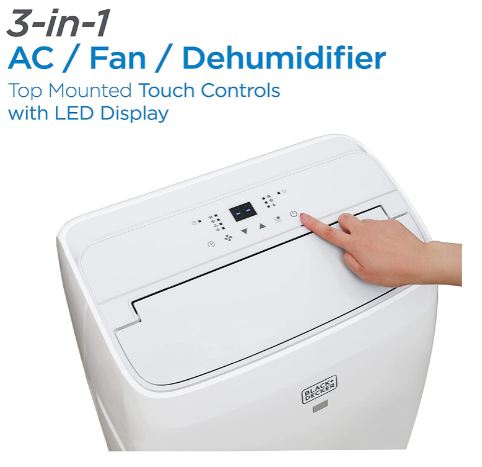
Why buy a Portable AC Unit for Your Apartment over Other Kinds?
There are 4 main types of air conditioners in the market currently:
- Split AC
- Window AC
- Floor Standing AC
- Portable AC
The first two are mounted on or through walls, which means they involve drilling into walls and are fairly immovable. Since they involve drilling, such units are not the ideal option for renters living in apartments.
Not only do some Home Associations prohibit drilling into walls, but such installations also add to the overall costs of housing. You have to pay for installing and removing the machine and pay for the repair of the walls in damages.
Moreover, split and window ACs have outer units fitted on roofs or external walls. Again, most apartments don’t have roof space, and appropriate wall space is also very rare. All in all, they are not the best choice for apartments.
On the other hand, floor-standing ACs are powerful and don’t require installation, but they are extremely expensive. So, they are a luxury not everyone can afford or even consider buying.
A portable AC then offers the best value for your money. These are powerful enough to cool down an apartment thoroughly. They are also easy to wheel from room to room, making them just the perfect fit for a single-story apartment where multiple rooms are in use.
What to look for When Buying a Portable Air Conditioners for an Apartment
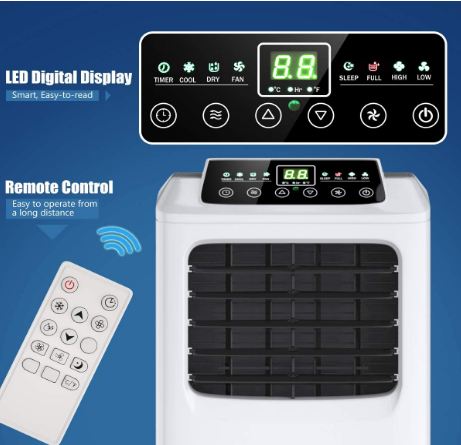
Here are some key features to watch for when buying a portable air conditioner for your apartment.
Room size vs. AC size
Getting the largest possible unit within your budget might seem like an intuitive approach, but it’s definitely not the smartest one.
The best AC to cool your room is not the biggest one, but one that’s the right size for that room.
If you get too big a unit, it will successfully cool the room but result in a clammy environment. This is because the air conditioning will work too fast and cool the room before the exhaust properly eliminates excess humidity from the air.
In contrast, an air conditioner that is too small for the room it’s placed in will never be able to fully cool that room. It will constantly be overloaded and will lead to higher electricity bills without much value for the money.
So, you need to match the size of your room (measured in square feet) to the power of the AC (measured in BTUs). Here’s a quick guide to help you pick the right air conditioner for your room:
The infrastructure of Your Apartment
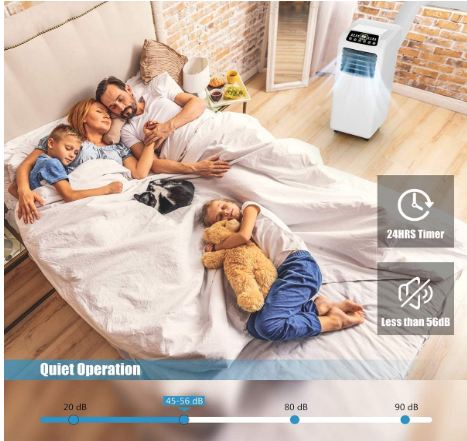
You need to consider the vicinity your apartment is located in.
Some areas allow through-the-wall or wall-mounted ACs, while some do not.
Portable ACs are typically not wall-mounted or through-the-wall, but some users prefer fitting them on a wall regardless. This is why you should keep your local building laws in mind before making the big purchase.
You also need to consider the drainage system. AC units produce a significant amount of water residue.
If you go for a self-evaporating model, the residue will evaporate on its own and be no issue at all. If not, you will have to manually empty the residual water bucket or attach a drainage hose to the AC.
The drainage method you choose depends on your use since that determines how much water residue is produced.
If you expect to have the AC turned on for the greater part of the day, you will be dealing with a larger volume of residual water. This is when you need to consider the infrastructure of your apartment.
If you can easily arrange for a drainage hose to lead into a drainage area, go for a model that supports drainage pipes.
Alternatively, choose a model with a large water bucket, so you don’t have to empty the bucket too often during the day.
Climate
Portable air conditioners require some water in their tanks. They then cool the ambient air by turning the water into cool water vapors.
Because they release water vapors into the air, they create a slightly humid environment. This is perfect for drier climates; however, it might be a problem in humid areas.
Power Consumption
Depending on how long you run your portable AC, you will see an increase in your electricity bills.
We recommend referring to the directory of Portable Air Conditioners put together by Energy Star. They have rated different models on their energy efficiency, so you can conveniently compare brands and variants.
If cutting down electricity consumption is a priority for you, get a portable AC with a programmable thermostat. Such models allow you to preset a value for the desired temperature. Once the system detects that the preset temperature has been attained, the AC turns off automatically.
AC units with programmable thermostats can be a tad pricey. Another cheaper option is a portable AC with a built-in timer. You can set the timer before, let’s say, dozing off for a nap. The AC will automatically switch off once the time runs out. No more forgetting to turn the AC off!
Costs and Warranty
Portable ACs for apartments vary significantly in price. They typically range between $150 and $800, but they can even go over $10,000 if the unit is designed for heavy, commercial-grade usage.
The price difference is due to a wide variety of features. However, the single most influential feature is the cooling capacity of the air conditioner.
This is why you should expect to pay more if you want your machine to cool a large living space. In contrast, ACs designed for smaller rooms will be far lighter on the pocket.
Additional features in the AC further dictate the price. Multipurpose variants that double as dehumidifiers or heaters naturally cost a lot more than a basic, entry-level air conditioner.
Similarly, WiFi compatibility, self-evaporation, programmable timers, and remote controls also tip the price scale upwards.
The price tag of the AC is not the only cost you need to consider.
The electricity costs of running the unit as well as the maintenance costs over the years will also add up. This is why we recommend steering clear of ‘cheaper’ ACs that lack durability and energy efficiency.
When the operating costs pile up, such pieces end up costing you way more than a high-quality one with a slightly heavier price tag would have.
So, go for an Energy Star-rated, highly energy-efficient model with a sturdy build and powerful filters, even if you have to stretch your budget a little for that. It will keep your electric bills down and work seamlessly for years to come.
Pros and Cons
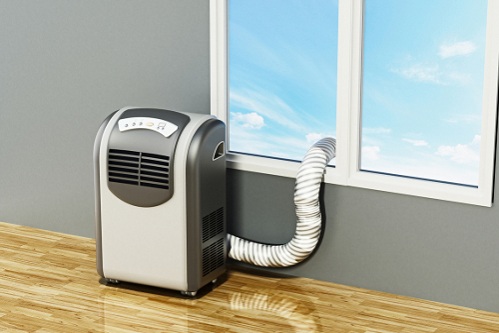
Pros:
- No complex installation: Portable ACs only need a window nearby to house the ventilation system. Other than that, there is no need for drilling and any setup. This helps save both time and money.
- Convenient to wheel from room to room: This gives you the leverage of only buying one AC for the whole house and saves the hefty sum of installing a separate AC in each room. You can simply wheel it to whichever room it's needed in. You can also move them to parts in the house where central air conditioning is not present or areas with poor ventilation where a standard AC would fail to work. Think garages and terraces.
- Convenient to wheel from room to room: This gives you the leverage of only buying one AC for the whole house and saves the hefty sum of installing a separate AC in each room. You can simply wheel it to whichever room it's needed in. You can also move them to parts in the house where central air conditioning is not present or areas with poor ventilation where a standard AC would fail to work. Think garages and terraces.
Cons:
- Not for large spaces: Portable ACs are not powerful enough to support large living spaces on their own. If you need to cool an entire house, you can use a portable unit to supplement the main central air conditioning system. However, it would be unrealistic to expect a portable unit to do the job on its own.
- They require drainage: Portable ACs do not have condensers outside of the main body. So, you need to arrange for water drainage yourself. You can set up a drainage hose to automate the drainage, but if the unit does not support that, you will have to manually empty the condensate bucket.
Frequently Asked Questions

Do portable air conditioners require any unusual power accommodations?
No! Most, if not all, portable air conditioners use a standard household voltage of 115 Volts or 60 Hertz to operate.
Usually, these units have a 3-pronged plug. Most household power sockets support this arrangement; however, an adapter can make up for the lack of it just as well.
What happens to the moisture that is pulled out of the air from the apartment?
Air conditioners remove humidity from the surrounding air. This collected moisture goes into the condensate bucket of the AC.
Most portable ACs can remove this moisture via evaporation and are known as self-evaporating ACs.
They get rid of the moisture by spraying the water from the condensate tank over a hot condenser coil. When the water comes in contact with the hot coil, the heat turnsit from droplets into vapors. The vapors then evaporate.
Some less advanced models are not self-evaporating. For such models, you need to empty the condensate bucket manually. A signal on the control panel of the AC usually indicates a full tank, which you can use to your advantage.
Is it possible to cool my entire apartment with one air conditioner?
This depends on how big your apartment is, how powerful your AC is, and the kind of AC you have.
Window ACs typically aren’t whole-home solutions. However, with powerful portable and split ACs, you can cool a smaller apartment by running just one unit.
Start by shutting all windows, so no hot air comes in. Then, close off all entrances and exits except the ones linking the different rooms in the apartments. Then power the AC on at full fan speed and the lowest temperature setting. Try not to use the oven or stove in the meantime, and this should do the job.
Which AC is more powerful for an apartment: window or split?
In terms of power consumption and BTUs, split ACs use more energy than window ACs and have higher BTU measurements as well. This is intuitive because window ACs are single units, while split ACs house two units in one body.
However, where cooling power and efficiency is concerned, there is no clear winner.
Depending on the layout and Infrastructure of your apartment, either type can do a good job. Window units are better suited to smaller apartments with lower humidity and relatively cooler climates.
In contrast, split ACs work better and faster in hotter, more humid regions and larger apartments.
Final Verdict: What is the Best Portable Air Conditioner for an Apartment?
For us, the Black+Decker BPT10WTB is the best portable air conditioner for apartments.
We love it for its formidable 10,000 BTU cooling power, compact, lightweight, and bucket-less design, 3-in-1 functioning, easy controls, and fuss-free maintenance.
The best bit? It’s easy on the pocket, too.
I’m a degreed ME (mechanical engineer) who is passionate about machines of all kinds. I created MachineWonders.com as a way to connect with others who love machines like me – or need help choosing one for their needs, application, or situation.

